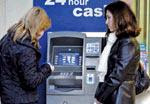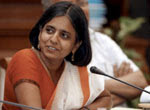When IIPM comes to education, never compromise Business ethics, social responsibility and customer friendliness comprise its philosophy
“I will

rather opt for zero business than doing business worth millions which are based on unethical practices,” said the HDFC CEO at an internal organisational meeting a few months ago. Reminiscing about it, an ex-employee explains that this one sentence epitomises the business philosophy of a corporate, whose ethical mindset and environment is shaped by those at the top. As an organisation, HDFC encompasses the simple, but mostly forgotten, tenets of integrity, transparency and fairness in whatever it does. These fundamental and sound principles have increased its credibility and have made it one of India’s most admirable companies.
Here’s an example to establish this fact. Another former employee explains how he had cracked a lucrative deal with a large company to handle its gratuity and pension funds. Later, the client was unable to fulfil some compliance norms and present some of the documents. “We were in a position to still accept the statement from the client. But as an organisation governed by ethical principles and practices, we simply refunded the entire amount.” As he narrated the story, the admiration for his ex-company was clearly visible. Each and every relationship that HDFC strikes with borrowers, depositors, agents, shareholders, or other stakeholders is valued and that explains why most former and current employees proudly proclaim their relationship with HDFC.
In an era where success or failure of organisations is judged by respective toplines, bottomlines, market capitalisation, and market shares, HDFC seems to be an exception. “HDFC has followed the basics, and focused primarily on quality rather than quantity. Its approach has been customer-centric and this has certainly helped them achieve quality. They are not into customer acquisition, but believe in building long and cherished relationships built on trust with customers. It takes into consideration customer’s feedback and this has helped it to constantly innovate products based on the customer’s needs. The quality of service too is unparalleled,” exudes Sumit Taneja (who has invested in HDFC Mutual Fund). It has neither believed in the market share game, nor does it compete on price points. Its focus throughout has been on transparency, professionalism and customer services without comprising on quality. While HDFC agrees that market share is important, yet it does not want to engage itself in any practices that would hurt long-term profitability, or worse, the credibility and image of the company. Defying the commonly-held belief that numbers are critical, HDFC and its several subsidiaries have occupied coveted positions merely by focusing on “need-based selling strategy.” If customers require a certain product or service, HDFC will launch it.
This does not mean that the Bank is not gaining market share. In the housing finance segment, HDFC’s market share in the first quarter of current financial year has moved up from nearly 29% to about 35%. In comparison, most competitors have seen their housing finance business witness a downturn; for many, growth rates were down by 40%. HDFC has not only added value to shareholders wealth, but has also strived to add the much-needed value for the country. And its efforts towards betterment of the poor are no less than the efforts to make its business strong.
To cite an example, HDFC bank follows a four-tier pyramid structure to provide microfinance to poor farmers. At the first tier, it offers amounts ranging between Rs. 5,000 and Rs. 12,000 through self-help groups. At the second level, it helps those who need finance to take care of harvested crops. The Bank also offers pre-house and post-house warehouse receipts finance to help farmers get a better price for their produce. It has dedicated sales machines in more than 1,000 co-operative banks, which are involved in the microfinance business. Due to constant efforts, HDFC feels that it can quadruple its microfinance business from the existing Rs 500 crore to Rs 2,000 crore in next 24-30 months, and cover six million poor families.
But having social principles as a foundation is not enough. And HDFC understands this principle. While ensuring that the Bank has a strong footing in the market, it has chalked out clear financial objectives. These include increasing return on equity every year (by one percentage point), maintaining gross Non Performing Assets (NPAs) below industry norms (it was under1% on six months overdue basis), growing loan approvals by 25% per annum, and maintaining a cost-to-income ratio below industry norms (HDFC’s was under 14%). It earned a PAT of Rs 1,019.20 crore in the first half of 2007-08, which was higher than the Rs. 664.84 crore it earned in the same period in the previous fiscal. According to Keki Mistry, MD, HDFC, the Bank will be able to sustain a 25% growth over the next few years. HDFC has positioned itself as a bank that’s approachable and easier to deal with. No wonder, it proudly boasts of the Best Retail Bank in India award (conferred it to at the 6th Asian Banker Excellence in Retail Financial Services Award).
In other businesses, like life insurance, the HDFC brand is making inroads into rural areas, and stretching distribution networks at the grassroots level. In the general insurance business, HDFC has overcome niggling problems it faced initially, like the HDFC Chubb fiasco, and is racing ahead after striking a deal with ERGO. But, in sync with the underlying business philosophy, all businesses are loaded with tons of of ethics, social responsibility and customer friendliness. For HDFC, its customers are its deserving ambassadors.
Edit bureau: Gyanendra Kashyap with inputs from Niharika Patra
For more articles, Click on
IIPM Article.
Source :
IIPM Editorial, 2008
An Initiative of
IIPM,
Malay Chaudhuri and
Arindam chaudhuri (
Renowned Management Guru and
Economist).
For More IIPM Info, Visit below mentioned IIPM articles.
IIPM, GURGAON
IIPM - Admission Procedure
IIPM is A World of Career
Why Study Abroad When IIPM Gives You 3 global Advantages!




 Santosh Desai believes that brands now-a-days, are clearly seeking a much larger platform, as also a role to play in the social life of consumers. “The Surf ‘Do bucket pani...’ spot for example, endeavours to connect with the audience on a larger platform. There was a time when brands shied away from reality, showcasing their product attributes in a make-believe world using either humor or glamour to tell their story. But, brands are no longer running away from reality, instead they are celebrating it,” he avers.
Santosh Desai believes that brands now-a-days, are clearly seeking a much larger platform, as also a role to play in the social life of consumers. “The Surf ‘Do bucket pani...’ spot for example, endeavours to connect with the audience on a larger platform. There was a time when brands shied away from reality, showcasing their product attributes in a make-believe world using either humor or glamour to tell their story. But, brands are no longer running away from reality, instead they are celebrating it,” he avers. growth of 11.4% – highest amongst the PSUs, even better growth in profits… no wonder why it made it to the list. But the good news is Oriental Insurance Company Ltd. is expecting to keep up the good work. According to M. Ramadoss, CMD, Oriental Insurance Company, “We hope to continue our path of profitable growth of at least 10% in the current year.” Well, it doesn’t end here! The company is currently in the middle of developing its IT infrastructure in order to step up its efficiency levels as Ramadoss makes it clear, “In FY 07-08, our focus would be on developing information and technology software for our business.” To substantiate the fact, the Integrated Non-life Insurance Application Software (INLIAS) is being tried out on a pilot basis, in more than 250 offices and will be further implemented in 600 of its branches. The implementation of this software is being done with an objective to speed-up the company’s operations across the board and will also unlock efficiency in areas as diverse as claims, underwriting, re-insurance, accounts et al. The company seems to be quite categorical about increasing its focus on some specific sectors like health, rural cover and personal accident.
growth of 11.4% – highest amongst the PSUs, even better growth in profits… no wonder why it made it to the list. But the good news is Oriental Insurance Company Ltd. is expecting to keep up the good work. According to M. Ramadoss, CMD, Oriental Insurance Company, “We hope to continue our path of profitable growth of at least 10% in the current year.” Well, it doesn’t end here! The company is currently in the middle of developing its IT infrastructure in order to step up its efficiency levels as Ramadoss makes it clear, “In FY 07-08, our focus would be on developing information and technology software for our business.” To substantiate the fact, the Integrated Non-life Insurance Application Software (INLIAS) is being tried out on a pilot basis, in more than 250 offices and will be further implemented in 600 of its branches. The implementation of this software is being done with an objective to speed-up the company’s operations across the board and will also unlock efficiency in areas as diverse as claims, underwriting, re-insurance, accounts et al. The company seems to be quite categorical about increasing its focus on some specific sectors like health, rural cover and personal accident.


